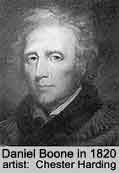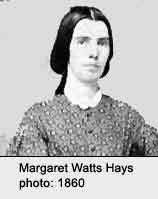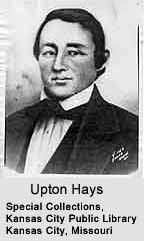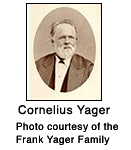Historical
Notes: (Revised 6/2006)
There
are 30 letters in this section. Not every letter is mentioned in
the history below. Each of the 30
letters can be read in full from the index at the right.
(To
return to the website's Main Menu click here or
scroll down.)
1849 - 1852
The first letter, Letter
1,
in this collection is by John S. Watts to his wife Elizabeth Watts and his
partners in Missouri, from Albuquerque,
New Mexico which
just had become a part of the United States as the result of the treaty with
Mexico at the end of the Mexican War in 1848. John S. Watts (1787-1860) was
born in North Carolina, the son of Richard Watts (1758-about 1824)
and Sarah Stubblefield.The
family (1) moved
to Washington Co., Kentucky when John was a child. John
S.
Watts served in the War of 1812 and when he returned home in 1814 he married
Mary Schooling (1791-1835) and became a farmer in Washington County, Kentucky.
They had ten children before Mary died in 1835, but only five survived the
rigors of frontier life (2).
In December 1835 he married a widow with several children, Elizabeth Ewing
Berry Yocum (1795-1876). John
and Elizabeth
had a daughter,
Margaret
Jane Watts (1836-1923) and after her birth they moved the family to Callaway
County, Missouri where their son Andrew Jackson “Jack” Watts (1838-1894)
was born. Shortly after Jack’s birth they moved to northern Van Buren
(Cass) County, Missouri. In the 1840’s John entered the race for the
Missouri State legislature but did not win in the election (see
original circular).
To the north of Cass Co., Jackson Co. was a major staging area for settlers heading
west across the plains to Oregon and California. When he learned that gold had
been discovered in California, John S. Watts took the notion to go to California.
Being a prudent man, he found partners to help finance the journey and invested
in cattle. The Watts party set out in the spring of 1849 with wagons, horses
and the herd of cattle. They took the Santa Fe Trail south and west from Missouri
to Santa Fe, then followed the Rio Grande River south to the beginning of the
Old Spanish Trail which went west to Southern California. In 1850, he and his
sons were in Cold Springs to the east of Coloma where gold was discovered in
1848.
John S. Watts was on the Santa Fe Trail to California, but his great-granddaughter,
Floy Hays Forbes, wrote in her California Pioneer Record: “The Watts family
was with a train camped at Ft. Bridger when a messenger came saying that gold
had been discovered in Cal. [They were] going to Oregon but the train split up
and part of them came to Calif”. Ft. Bridger is east of Salt Lake City
on the Oregon Trail in what is now Wyoming. By the summer of 1848 the word of
the gold discovery had spread to Oregon and travelers were carrying the news
back across the plains to Missouri.
Among the Missouri gold seekers in California were three of John’s sons;
John S. Watts, Jr. (1827-after 1901), Dewitt C. Watts (1829-before 1894), Cleon
B. Watts (1831-before 1900)and Jesse Yocum (1818 or 1830 – after 1850),
a son of Elizabeth Watts. Left behind in Cass County, Missouri with his wife
Elizabeth, were his youngest children, Margaret Jane and Andrew Jackson “Jack” Watts,
and also a married daughter, Letty Watts Rowland (1821-1910) and her children,
and the children of his daughter Mary Elizabeth Watts Berry (1823-1845). Eliza
Watts Dickerson (1813-after 1900), also a possible daughter of John S. Watts,
and her sons lived in Howard Co., Missouri. John S. Watts was 61 years old when
he led this party to California.
Letter 1a was written by Judge Joseph Schooling (1782-1850) from his home in Lawrence County, MIssouri to his niece, Martha A. Schooling Dickerson. She was the wife of John S. Watts' nephew, Beverly James Dickerson (1820-1863) and a cousin of John S. Watts' first wife, Mary Schooling.
Letter
2, by John Schooling Watts, Jr. (1827-1901) from Cold Springs,
El Dorado Co., California, a mining camp near the American River, to his sister
Margaret in
Cass County, Missouri was written in about 1850. He served with the Missouri
Mounted Volunteers in the Mexican War. When he returned home to Cass
Co., Missouri his father set him up with a wagon load of goods and he returned
to Mexico as a trader and then took passage on a ship to California where he
joined his father and brothers in El Dorado county. John Jr. was 23 years of
age when he wrote this letter.
The senior John S. Watts returned to Missouri in 1850. He, Elizabeth and his
son Jack joined a wagon train to California in 1852. The family settled in Mariposa
County, California. The elder Watts lived in the town of Mariposa where John
S. Watts became a Justice of the Peace. The branding iron which he used for his
cattle was acquired from Charles C. Fremont, the owner of the Spanish Land Grant
which included Mariposa.
Boone Hays(1783-1850) of Westport, Jackson County, Missouri, a grandson of Daniel
Boone, also led a party to California in 1849 but by way of the Oregon Trail.
Septimus Scholl (4),
Boone’s cousin, wrote in
an
1849 letter to
Rodney
M.
Hinde: “I will venture to inform you that Marcus [SCHOLL] started to California
on the 1st day of May in company with Cyrus R. SCHOLL of Callaway, Daniel MUIR,
Sylvester MUIR, Boone HAYS, Amazon HAYS, Linville HAYS, Upton HAYS, Cud Combs,
Fielding A. Combs, Sr., Dr. CALDWELL, together with a number of our acquaintances
....They went in company with Boone HAYS which consisted of 19 wagons and 60
men forming said company and do not expect to return before fall 1851...”.
Amazon, Linville and Upton were Boone Hays’ sons. According to Septimus,
Boone intended to settle in California but he died (5) of
pneumonia in
1850
and
was buried on a bluff overlooking the Feather River. His three sons returned
to Missouri and his youngest son, Upton Hays married John S. Watts’ daughter
Margaret Jane Watts on February 4, 1852 in Jackson County, Missouri. also led a party to California in 1849 but by way of the Oregon Trail.
Septimus Scholl (4),
Boone’s cousin, wrote in
an
1849 letter to
Rodney
M.
Hinde: “I will venture to inform you that Marcus [SCHOLL] started to California
on the 1st day of May in company with Cyrus R. SCHOLL of Callaway, Daniel MUIR,
Sylvester MUIR, Boone HAYS, Amazon HAYS, Linville HAYS, Upton HAYS, Cud Combs,
Fielding A. Combs, Sr., Dr. CALDWELL, together with a number of our acquaintances
....They went in company with Boone HAYS which consisted of 19 wagons and 60
men forming said company and do not expect to return before fall 1851...”.
Amazon, Linville and Upton were Boone Hays’ sons. According to Septimus,
Boone intended to settle in California but he died (5) of
pneumonia in
1850
and
was buried on a bluff overlooking the Feather River. His three sons returned
to Missouri and his youngest son, Upton Hays married John S. Watts’ daughter
Margaret Jane Watts on February 4, 1852 in Jackson County, Missouri.
Letter 3 is by Margaret
Jane Watts Hays to her parents in Mariposa, California. Margaret and her husband
Upton
Hays
(1831-1862) lived
on a farm near
Westport,
Jackson County, Missouri on part of the land lived
on a farm near
Westport,
Jackson County, Missouri on part of the land  settled in the early 1800’s
by Morgan Boone and his sister Susannah Boone Hays, children of the pioneer,
Daniel Boone. Boone Hays bought the property in 1836 (6).
Upton Hays was a wagon master and farmer. He hauled freight by wagon train to
Santa Fe, Salt
Lake
City
and other places west of Missouri. Two of Upton’s brothers, Linville (1821-1896)
and Amazon (1820-after 1880) Hays were also freighters and farmers. Upton, Amazon
and another brother, Samuel Hays (1824-1872) and a sister, Mariam Hays McMurtry
(1826-after 1880) and their families lived on adjoining or nearby farms. Amazon
and Samuel Hays were both married to Margaret’s cousins, Berry nieces of
Elizabeth Watts. Linville Hays, at this time, lived near Lee’s Summit with
his wife’s relatives, the Holloways. Margaret was 17 years old when she
wrote this letter. settled in the early 1800’s
by Morgan Boone and his sister Susannah Boone Hays, children of the pioneer,
Daniel Boone. Boone Hays bought the property in 1836 (6).
Upton Hays was a wagon master and farmer. He hauled freight by wagon train to
Santa Fe, Salt
Lake
City
and other places west of Missouri. Two of Upton’s brothers, Linville (1821-1896)
and Amazon (1820-after 1880) Hays were also freighters and farmers. Upton, Amazon
and another brother, Samuel Hays (1824-1872) and a sister, Mariam Hays McMurtry
(1826-after 1880) and their families lived on adjoining or nearby farms. Amazon
and Samuel Hays were both married to Margaret’s cousins, Berry nieces of
Elizabeth Watts. Linville Hays, at this time, lived near Lee’s Summit with
his wife’s relatives, the Holloways. Margaret was 17 years old when she
wrote this letter.
1854-1856
The Hays property near Westport was only ten miles from the Kansas border. Between
the time of Margaret Hays 1854 letter and her April 1856 letter Letter
4 the
controversy over slavery had intruded into her family’s peaceful life.
The passage of the Kansas Nebraska Act in 1854 created the Territory of Kansas
and nullified the Missouri Compromise which had maintained the balance of power
between the slave and free states. The people of Kansas would have to choose
whether slavery would be legal or not and almost immediately pro-slavery Missourians
began moving into Kansas Territory. They were soon followed by settlers from
the free states, sent or assisted by emigration societies. Missourians crossed
the border to vote in the Kansas elections and the Southern faction rapidly elected
a pro-slavery legislature which enacted a strict penal code against all interference
with the institution of slavery(7).
In 1855 the free-state settlers adopted
a
constitution and in 1856 set up their own government. The radical abolitionist
John Brown
who became Captain of the 5th Regiment, 1st Brigade, Kansas (Free States) Volunteers
on May 5, 1856 led the Pottawattamie Massacre, three days after Missouri Border
Ruffians burned and sacked Lawrence, Kansas. The free-staters prevailed and became
the legal authority in July 1856. The summer and fall of 1856 were months of
turmoil in Kansas as groups of both pro-slavery and abolitionists pillaged and
occasionally killed settlers.
How Upton Hays was involved in this conflict is unclear but Margaret Hays wrote
to her mother that his life was in danger. In about June of 1856 he and his brother
Sam went to Texas to look for suitable land for their families. By the time Upton
returned the conflict had quieted down and people had turned to economic pursuits.
People who had been bitter enemies worked side-by-side to take advantage of the
opportunities in this new territory. Kansas Territory had become “free” but
the constitution virtually excluded free people of the Negro race from living
in the territory(8).
Slaves belonging to a family of settlers were allowed and
not given their freedom.
1858
Letter
9 was written by Upton and Margaret Hays. One story told
about Upton Hays was that when he was 12 years old his family decided that he
needed some formal
schooling so they sent him to school. Within a week he had left to join a Mexican
wagon train to Santa Fe and the story goes that he soon became the leader of
the party. Boone Hays, his father, had taken Upton and his brothers on various
trips, one to Virginia and possibly to California before the Gold Rush. Boone
and his boys were noted for their strong voices. It was said that when they shouted
that their voices could be heard for a mile.
By 1858, Margaret and Upton had three children, John Nathan Hays (1854-1918),
Mary Elizabeth “Betty” Hays (1856-1944) and Elfleda "Fleda" Hays (1858-1943).
Since Upton Hays was away from the farm with his freighting business during most
of the summers, Margaret was left in charge of the household and farm. Family
stories tell that Upton Hays sent a herd of cattle to California in about 1858
and left them in Tehama County until they could be sold. Apparently the demand
for beef was not very great, and it proved difficult to sell them. Upton Hays
joins his wife Margaret in writing two of the letters in 1858.
1859
The Kansas Missouri Border War was heating up again, causing a great deal of
anxiety among the slave-holding Missourians along the Kansas-Missouri border.
Captain John Brown of the Kansas Volunteers rode into Missouri and attacked two
homesteads, liberating eleven slaves. Upton and William C. Quantrill, who later
became notorious as a Confederate Guerilla in the Civil War, went to Utah together(9). Upton Hays and his partners had contracts with the United States Government to deliver supplies to Utah and Quantrill most likely worked for the partners.
Upton owned one slave but he was also the agent for Elizabeth Watts’ slaves.
When Elizabeth migrated to California in 1852 she left the Watts’ “blacks”,
as she termed these people of African descent, with the young couple. Most of
these people had been the property of Margaret’s half-brothers Matthew
and Berry R. Yocum who both had died in the 1840’s. According to the probate
records of the Yocum brothers in Cass County(10), the slaves had been divided
among
the heirs: Elizabeth, Margaret and Jack Watts and the children of the brothers.
It appears that an effort was made to keep the Negro family together by Elizabeth
Watts who consigned them to the care of Upton and Margaret. They are mentioned
by name in Letter
6.
1860-January 61
The 1860 United States Census for Jackson County, Missouri, District 35 which
included Westport showed Upton Hays, age 29, a Farmer, with property worth $7,531
and an income of $2,100, born in Missouri. Margaret Hays was 24 and the children;
John was 7, Mary E. was 5, and Elfleda was only 2 years old. Living on the farmwas Peter L. Utz, age 25, Laborer, born in Virginia and James Hunter, a freighter
who owns no property but has an income of $10,000, born in Kentucky.
The 1860 United States Census Slave Schedule lists Upton Hays: one black male,
65 years old and Upton Hays, Agent for Elizabeth E. Watts, 6 blacks ranging in
age from 6 months to 60 years. Upton’s brothers and sister living nearby
were also listed. Amazon Hays had 7 slaves and 2 were fugitives. Samuel Hays
had 5 slaves, some were fugitives, Mariam Hays McMurtry had 3 slaves, an 18 year
old female with two children, all fugitives. Linville Hays had no slaves. The
abolitionists had been coming across the border and taking the blacks with them
to start their journey to where they could live as free people. Imagine the courage
of these people, leaving their homes for the hard and uncertain journey, hounded
by slave catchers, men paid to bring back or kill the fugitives.
1860 was a presidential election year and President James Buchanan
was struggling to hold the Union together in his last year in
office. Margaret’s cousin,
Abraham Lincoln was nominated as a candidate for the Presidency, supported by
the free-staters and abolitionists. Not only were tensions rising over the slavery
issue but there was a drought; people were going hungry and their livestock was
dying as the water holes dried up. Letter
26 is
from Elizabeth Watts to the Hays family in Missouri. Elizabeth’s
grandparents, Rachel Shipley and Richard Berry, had moved their family from Virginia
to Kentucky after the Revolutionary War. Rachel’s sister, who had married
Thomas Hanks, died and their daughter, Nancy Hanks, became their dependent. Richard
and Rachel were elderly so Nancy went to live with their son Richard Berry, Jr.
and his family. Elizabeth Ewing Berry, Richard Jr.’s oldest daughter and
Nancy Hanks became very fond of each other and when Nancy married Thomas Lincoln
in 1806 she gave the younger cousin her wooden yardstick as a keepsake. Elizabeth
kept this memento with her until she left for California in 1852, when she gave
it to her daughter Margaret.

Margaret’s father, John S. Watts died on August 26, 1860 in Mariposa,
California. His obituary is from the Mariposa Gazette:
Died: In Mariposa, California, August 26,1860,
of Apoplexy, Mr John S. Watts, aged 73 years. Mr. Watts was a native
of North Carolina
and emigrated to Kentucky
in 1794, where he resided with the exception of a short time in Missouri,
until he came to this State in 1849. Mr. Watts was an officer in
a Kentucky regiment
during most of the War of 1812, and took an important part in the Battle
of the Thames, Oct.5th, 1813, at which the great Indian Warrior
of the Northwest, Tecumseh,
fell, and the whole British force under Gen. Proctor was captured. Mr. Watts
came to this country a venerable man—one who seemed to live not only
for his family, but for the community and those coming after. He possessed
rare attractive
qualities and was looked to as a Patriarch, with affection and respect.
Night came to him after the limit of life, and he fell asleep as quietly and
peacefully as sleep rests upon the eyelids of infancy. His work was done, his
harvest task was ended, and he rests upon his sheaves.
Religious Notice -- The Funeral Sermon of Col. J. S. Watts, deceased, formerly
of this place will be preached in the M.E. Church, South, next Sabbath, Dec 30,
at 11 o'clock, A.M., by Rev. Mr Yager of Contra Costa.
Mariposa, Dec 25th 1860

Letter
27 is
to Elizabeth Watts from Rev. Cornelius Yager(11) (1811-1895),
a cousin and a
brother of
her sister’s husband, James B. Yager. “Nely” Yager
was a popular Cumberland Presbyterian Minister in Kentucky and Jackson Co.,
Missouri. He brought his family to California in 1850. In 1860 he was living
with his daughter,
Sarah E. Caldwell, in Antioch, Contra Costa Co. He was 50 years old when he
wrote this letter and in 1861 he went to Nevada to preach among the miners.
The typescripts
of the letters and other writings have been made as accurately as possible. The
spelling and grammar have been transcribed as written. Occasionally punctuation
and paragraph indentations have been added for clarity. Copyright: Marian Franklin
Footnote
1. The
children of Richard and Sarah Watts were: Elizabeth Watts 1877, Nancy Jane Watts 1879, Sarah Watts
1780 or 1784, John S. Watts 1787, William Russell Watts 1789, Frances Watts 1794. (back)
Footnote
2.:
The surviving children were: Letticia Stubblefield Watts (1821-1910),
Mary
E. Watts (1820-1845), John Schooling Watts, Jr. (1827 or 1829-1901), Dewitt Clinton
Watts (1829-about 1894), and Cleon Bolivar Watts (1831-?) (back)
Footnote
4..
Giulvezan, Isabel Stebbins, A Collection of Letters Written by the Scholl Family
and Their Kin, Jackson County Historical Society, Research
Library
and
Archives, Doc. #A2824F5, page 31. See also Coomb-Coombs Family website. (back)
.
Footnote
5.(note by his granddaughter Mary Elizabeth
Hays Moutrey) Boone Hays died in 1850 near Marysville above Sacramento & was buried
on a hillside by Feather River in sight of the Santa Fe trail. His grave was
marked
with a monument of stones. He was alone with old "Yankee White" an
old schoolteacher when he was taken with Quinsy & died very suddenly. His
son Upton arrived just before he died but the father was already speechless.(back)
Footnote
6. The location of the farm is now within
the Kansas City, Missouri
city
limits
at 63rd and Garfield Ave.(back)
Footnote
7. Woodrow
Wilson, Union and Reunion, 1829-1889, Collier Books, 1961
(orig.
pub. 1898), pages 157-158 (back).
Footnote 8. see
The Impending Crisis, 1848-1861 by David Potter, Harper & Row,
1976,
Chapter 9 (back)
Footnote
9. Kansas: a cyclopedia of state history,
embracing events, institutions,
industries,
counties, cities, towns, prominent persons, etc., Vol. I with a supplementary
volume devoted to selected personal history and reminiscence. Standard Pub. Co.
Chicago : 1912. 3 v. in 4. : front., ill., ports.; 28 cm. Vols. I-II edited by
Frank W. Blackmar. Transcribed May 2002 by Carolyn Ward.(back)
Footnote
10. Thanks to William L. Berry, a descendent
of Elizabeth Watt’s
uncle
Dr. William Jefferson Berry for providing these records.(back)
Footnote
11. Go to http://www.cumberland.org/hfcpc/minister/YagerC.htm
for an obituary of Rev. Yager. (The Cumberland Presbyterian, October 3, 1895,
pages
15-16 (back)
back to top |
